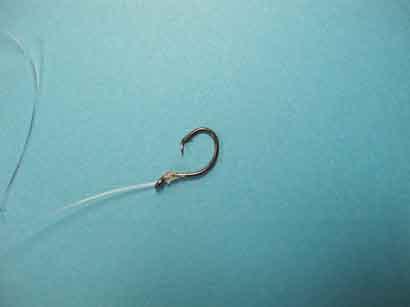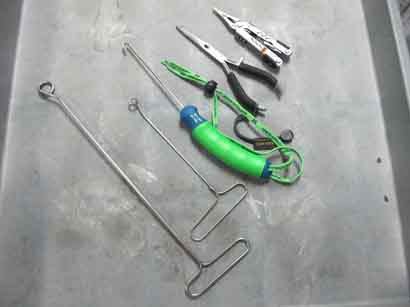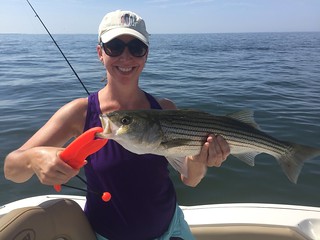Anglers have a responsibility to the fish and to other anglers to be knowledgeable, prepared and careful when playing, reviving and releasing a fish. A dead discarded fish is a tragedy.
Plan Ahead
- If you are fishing in the summer, check out the
Striped Bass Fishing Advisory Forecast.
- Know
fishing regulations, minimum sizes and limits.
- Use medium to heavy tackle suited to the size of the fish and bring fish in quickly.
- Have dehookers, pliers, gloves, net, gripping devices, and camera ready.
- If fishing from shore be prepared to wade into the water to meet the fish
and avoid dragging it up onto dry sand. - Flatten barbs on hooks and use circle hooks when you fish with natural bait.
- Avoid catch and release of medium and large striped bass in brackish Bay water warmer than 80 degrees and in air temperatures warmer than 95 degrees.
Handling Your Catch
- Keep your fish in water if possible.
- Use rubber or soft mesh landing nets.
- If you must handle fish:
- Use wet protective gloves.
- Do not lift fish vertically by jaw or gills.
- Do not use a rag to hold the fish, this will rub off the protective slime layer.
- Do not allow fish flop on boat deck or ground.
- Hold fish horizontal with support.
- Return fish to water quickly.
- Removing the Hook
- Remove hook whenever possible.
- Have proper tools handy and know how to use them.
- Be quick and careful.
- Releasing the Fish
- Return fish quickly and gently.
- Move exhausted fish slowly through water to force water through the gills.
Other Useful Tips
- Use larger circle hooks in the 8/0 - 9/0 size range
- When releasing striped bass, minimize handling and get the fish in the water
as soon as possible - Minimize heat stress to fish by avoiding fishing on days when air temperatures
are forecasted at 95 degrees Fahrenheit or higher. - Have appropriate de-hooking hardware on hand
- Keep fish in water when de-hooking
Circle hooks are an effective conservation measure because they significantly reduce “gut hooking” that leads to discard mortality. The department also launched and is continuing to expand an educational outreach program to assure compliance with these regulations.
Plan Ahead
Most fish species are managed by seasons, size limits, and creel limits. Study the rules and keep them handy for quick reference when you are out fishing. Keep a measuring stick, tape, or ruler nearby with size limits clearly marked for quick size determination. Go out knowing that you might have to return under-sized or over-the-limit fish.
Be Prepared
Make sure your gear is strong enough for the challenge of the fish you will target. Fighting or playing a fish on tackle that is too light may result in an exhausted fish that is unable to recover and live to fight another day. When a fish is played to exhaustion, lactic acid builds up in its muscles. The same thing happens to humans when we exercise. It's the lactic acid buildup that makes us tired from heavy activity. In fish these increased levels of lactic acid can lead to acidosis, a condition that may reach a point of no return, and the fish will die. Warm water will exacerbate the condition. Low salinity levels in marine and estuarine waters, and low oxygen levels in warm waters complicate the survival challenges for fish. Tired and exhausted fish need plenty of dissolved oxygen to balance the ph of their blood. Cool, salty water is helpful to the health and revival of marine and estuarine fish, especially if they are large.
Mortality studies of striped bass by department scientists show that fish larger than 24 inches are at the considerable risk when caught and released in warm, low-salinity waters. They may swim away when released, but the research shows that many do not recover and die hours later out of sight.
Catch and release mortality in mature striped bass increases depending on the temperature and salinity of the water. Stripers thrive best in cold, salty water. Additionally, studies show that large differences between water and air temperature, which is a common condition in the dog days of summer, can be a significant risk factor in striped bass release mortality. Any capture event is stressful to a fish, so, please be careful and quick in returning and reviving your fish, particularly on hot summer days.
A fish needs oxygen quickly after being fought on a hook and line. The only way that will happen is with water flowing across the fish's gills. Lifting the fish from the water is much like your trying to hold your breath for a minute after running a 200 meter dash. It's very important to quickly unhook the fish while keeping it in the water as much as possible. You can also minimize heat stress to fish by avoiding fishing on days when air temperatures are over 95 degrees Fahrenheit.
Terminal Tackle

When you are bait fishing, use circle hooks as they have proved to be lifesavers for hooked fish. While fishing with a
circle hook, allow the fish to pick up the bait and swim off. As the line begins to gently tighten, the baited hook will settle in the corner of the fish's mouth, and there will be no need to aggressively set the hook. The hook sets itself.
A deeply hooked fish may suffer internal damage, which could result in death. Studies show that about 68 percent of deeply-hooked fish die from the damage to internal organs.
Removing Hooks

Make every effort to gently remove hooks from fish. A functional de-hooker is your best tool for the job. If you can't put your hands on your de-hooker or some long-nosed pliers, and the fish is very deeply hooked, your last option is to cut the line near the hook eye, revive and release the fish, and hope for the best; but know that the prospects of survival for that fish are not good.
Circle hooks are the best option for minimizing stress and physical damage.
Long-nosed pliers can also do the job while minimizing your fish handling and possibilities of injury to your hands and the fish. This is particularly helpful when releasing toothy fish such as bluefish and sharks. Freshwater trout and pan fish anglers often use surgical hemostats to remove hooks from their fish because the tool is easy to keep in a pocket and it does an excellent job of clamping and controlling the hook.
Landing a Fish
If you must net a fish to control it before reviving and releasing it, use a soft net of small mesh nylon. Avoid using the large mesh polypropylene landing nets that were once popular. The rough mesh tends to scuff off the protective coating of the fish. Scraping away this protective slime opens the fish up to infection and disease. Striped bass in the Chesapeake Bay with damaged slime layers have developed infections that show up as reddened spots or discolored areas. If you need to handle a fish before letting it go, use wet protective rubber gloves or a wet towel to minimize damage to the fish's slime coating. Placing a wet towel over the fish's eyes and holding the fish down with wet gloves can calm the fish. Letting a fish flop around on the deck of a boat or on the shore is obviously a bad thing to do to a fish you intend to release.

A lip-gripping device such as the BogaGrip (eastabogatackle.com) can be helpful in controlling a large fish while you perform a hook removal. However, large heavy fish can suffer internal and jaw damage from being supported vertically by the mouth. Fish grow and live in a relatively weightless environment supported by the surrounding water. They are not used to the strains associated with being out of the water. Use the lipping tool to control the fish, not for lifting.
Never hold fish you intend to release by putting your hand in the gills. Just like lungs, gills are tender organs that can hemorrhage easily
If you must have a photo of the fish, cradle and support it with both hands. Have the camera ready and make sure the photographer understands how to use the camera before the fish is brought to the boat or shore. Speed is the name of the game for the fish's sake. As a guide to mark the limit of time you can keep a fish out of the water, try holding your own breath while you handle the fish.
When returned to the water, most exhausted fish can be held back by the tail and moved forward to get water moving through the gills. In the case of ram breathers such as tuna and marlin hold the fish towards the forward movement of a slow moving boat to allow water to flow through the mouth and over the gills.
